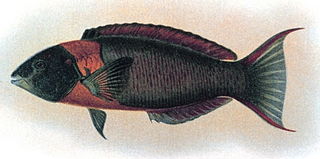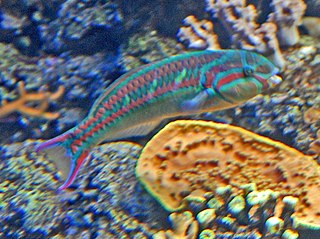
The wrasses are a family, Labridae, of marine fish, many of which are brightly colored. The family is large and diverse, with over 600 species in 81 genera, which are divided into 9 subgroups or tribes. They are typically small fish, most of them less than 20 cm (7.9 in) long, although the largest, the humphead wrasse, can measure up to 2.5 m (8.2 ft). They are efficient carnivores, feeding on a wide range of small invertebrates. Many smaller wrasses follow the feeding trails of larger fish, picking up invertebrates disturbed by their passing. Juveniles of some representatives of the genera Bodianus, Epibulus, Cirrhilabrus, Oxycheilinus, and Paracheilinus hide among the tentacles of the free-living mushroom corals & Heliofungia actiniformis.

Pseudolabrus is a genus of wrasses native to the eastern Indian Ocean and the Pacific Ocean.

Thalassoma is a genus of wrasses native to the Atlantic, Indian and Pacific Oceans.

Xyrichtys is a genus of wrasses native to the Atlantic, Indian and Pacific Oceans, where they are found in sandy-bottomed habitats. They are commonly known as razorfishes, as they are very laterally compressed with a sharp bony ridge at the front of their heads. This adaptation allows them to burrow very quickly into the sand at any sign of danger.
Giacomo Bernardi is a Professor of Ecology and Evolutionary Biology at University of California Santa Cruz. He earned his B.A., M.S., and Ph.D. at the University of Paris and did post-doctoral work from 1991 to 1994 at Hopkins Marine Station at Stanford University.

Halichoeres, commonly called wrasses, are a genus of fish in the family Labridae found in the Atlantic, Indian and Pacific Oceans.

The bluestreak cleaner wrasse, Labroides dimidiatus, is one of several species of cleaner wrasses found on coral reefs from Eastern Africa and the Red Sea to French Polynesia. Like other cleaner wrasses, it eats parasites and dead tissue off larger fishes' skin in a mutualistic relationship that provides food and protection for the wrasse, and considerable health benefits for the other fishes.

Pseudocheilinus is a genus of wrasses native to the Indian and Pacific Oceans.
Laboute's wrasse, Cirrhilabrus laboutei, is a species of wrasse native to the coral reefs of New Caledonia and Australia, where it occurs at depths of 7 to 55 m. This species can reach a total length of 12 cm (4.7 in). It can be found in the aquarium trade. The specific name of this fish honours Pierre Laboute who first photographed this species off New Caledonia and gave J.E. Randall advice on where to collect specimens.

The fivestripe wrasse, also known as the red-ribbon wrasse, is a species of marine ray-finned fish, a wrasse, from the family Labridae. It is found in the Indo-Pacific region.

The Cortez rainbow wrasse is a species of wrasse native to the eastern Pacific Ocean from Baja California to Peru, as well as around the Galapagos Islands. It is a reef inhabitant, occurring in small schools from the surface to depths of 64 m (210 ft), though rarely deeper than 25 m (82 ft) or shallower than 2 m (6.6 ft). It is generally very common. It can also be found in the aquarium trade. This species can reach 15 cm (5.9 in) in total length. It feeds on small organisms such as crustaceans, plankton and fish eggs, and the young are cleaner fish.

The Noronha wrasse is a species of wrasse native to the western Atlantic Ocean off the coast of Brazil and nearby islands, where it inhabits coral reefs from the surface to 60 m (200 ft) deep, though mostly much shallower, between 2 and 5 m. Younger individuals act as cleaner fish. This species can reach 13.3 cm (5.2 in) in standard length. It can also be found in the aquarium trade.

The creole wrasse is a species of wrasse native to the western Atlantic Ocean.

The pearly razorfish or cleaver wrasse, Xyrichtys novacula, is a species of wrasse. It is of minor importance to local commercial fisheries and is popular as a game fish. It can also be found in the aquarium trade.

The dwarf wrasse, Doratonotus megalepis, is a species of wrasse native to tropical waters of the western Atlantic Ocean from Florida, United States, to Brazil and in the eastern Atlantic from around Ile Las Rolas, São Tomé and the Cape Verde Islands. It is found in beds of turtle grass at depths of 1 to 15 m, where its green coloration allows it to blend in with its surroundings. This species grows to a total length of 9.4 cm (3.7 in). It can be found in the aquarium trade. This species is the only known member of its genus.

Iniistius is a genus of wrasses native to the Indian and Pacific Oceans.

The seagrass wrasse, Novaculoides macrolepidotus, is a species of wrasse native to the Indian Ocean and the western Pacific Ocean. It can be found in lagoons and mangrove forests in seagrass beds or on sandy areas with plentiful algal growth. It occurs at depths from the surface to 10 m (33 ft). This species grows to 16 cm (6.3 in) in total length. It can be found in the aquarium trade. This species is the only known member of its genus. The juveniles and smaller adults of this species are Batesian mimics of the venomous waspfish in the genus Ablabys. When threatened, these fish dive headfirst into the sea grass or sea weed beds they inhabit.

Novaculops is a genus of wrasses native to the Indian and Pacific Oceans.

Stethojulis is a genus of wrasses native to the Indian and Pacific Oceans.

Liopropoma is a genus of marine ray-finned fish, related to the groupers and included in the subfamily Epinephelinae, part of the family Serranidae, which also includes the anthias and sea basses. They are sometimes seen in the marine aquarium trade.


















